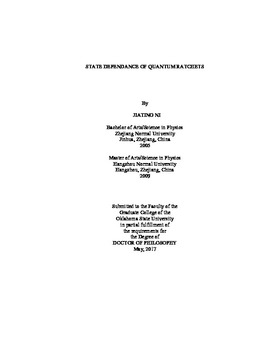| dc.contributor.advisor | Summy, Gil S. | |
| dc.contributor.author | Ni, Jiating | |
| dc.date.accessioned | 2018-06-25T13:38:27Z | |
| dc.date.available | 2018-06-25T13:38:27Z | |
| dc.date.issued | 2017-05 | |
| dc.identifier.uri | https://hdl.handle.net/11244/300257 | |
| dc.description.abstract | This dissertation reports on the experimental investigation of quantum state evolution using the atomic-optical quantum delta kicked rotors (AOQDKR) with a Bose- Einstein condensate (BEC) of 87Rb atoms. To achieve the AOQDKR, a BEC was periodically exposed to short pulses of a horizontal optical standing wave which was formed from the interference of two off-resonant laser beams. In the first set of experiments, the fidelity (overlap) between the perturbed and unperturbed quantum states was studied. To study the fidelity of quantum state evolution, ε-classical maps with different kicking strength was given. It shows that as the kicking strength gets stronger, the area of the island is smaller while the chaotic region gets bigger. Experimentally a perturbation was introduced to the system by applying different kicking strength, the overlapping of the momentum distribution of these two sets of experiments decays with the perturbation. The effect of finite pulse length was also discussed: the fidelity decay rate is proportional to the pulse length. In the second set of experiments, the quantum ratchet with different initial states was studied. The theoretical analysis of the intrinsic mechanism of a quantum ratchet illuminates that peaks in the wave function of the initial state containing more than one plane waves arise at positions where the gradient of the standing wave happens to be the greatest. The more of the plane waves, the higher and narrower of the peaks. Experiments were carried out to observe an on-resonant atomic ratchet by exposing an initial atomic state which was a superposition of two or more momentum states to the AOQDKR. The dispersion of the momentum of ratchet current was measured as a function of kick number t. The strong ratchet current gives a small dispersion. It was verified that the ratchet current was stronger with an initial state containing more consecutive momentum states. | |
| dc.format | application/pdf | |
| dc.language | en_US | |
| dc.rights | Copyright is held by the author who has granted the Oklahoma State University Library the non-exclusive right to share this material in its institutional repository. Contact Digital Library Services at lib-dls@okstate.edu or 405-744-9161 for the permission policy on the use, reproduction or distribution of this material. | |
| dc.title | State dependence of quantum ratchets | |
| dc.contributor.committeeMember | Mintmire, John W. | |
| dc.contributor.committeeMember | Rosenberger, Albert Thomas | |
| dc.contributor.committeeMember | Hoff, Wouter D. | |
| osu.filename | Ni_okstate_0664D_15016.pdf | |
| osu.accesstype | Open Access | |
| dc.type.genre | Dissertation | |
| dc.type.material | Text | |
| thesis.degree.discipline | Physics | |
| thesis.degree.grantor | Oklahoma State University | |
